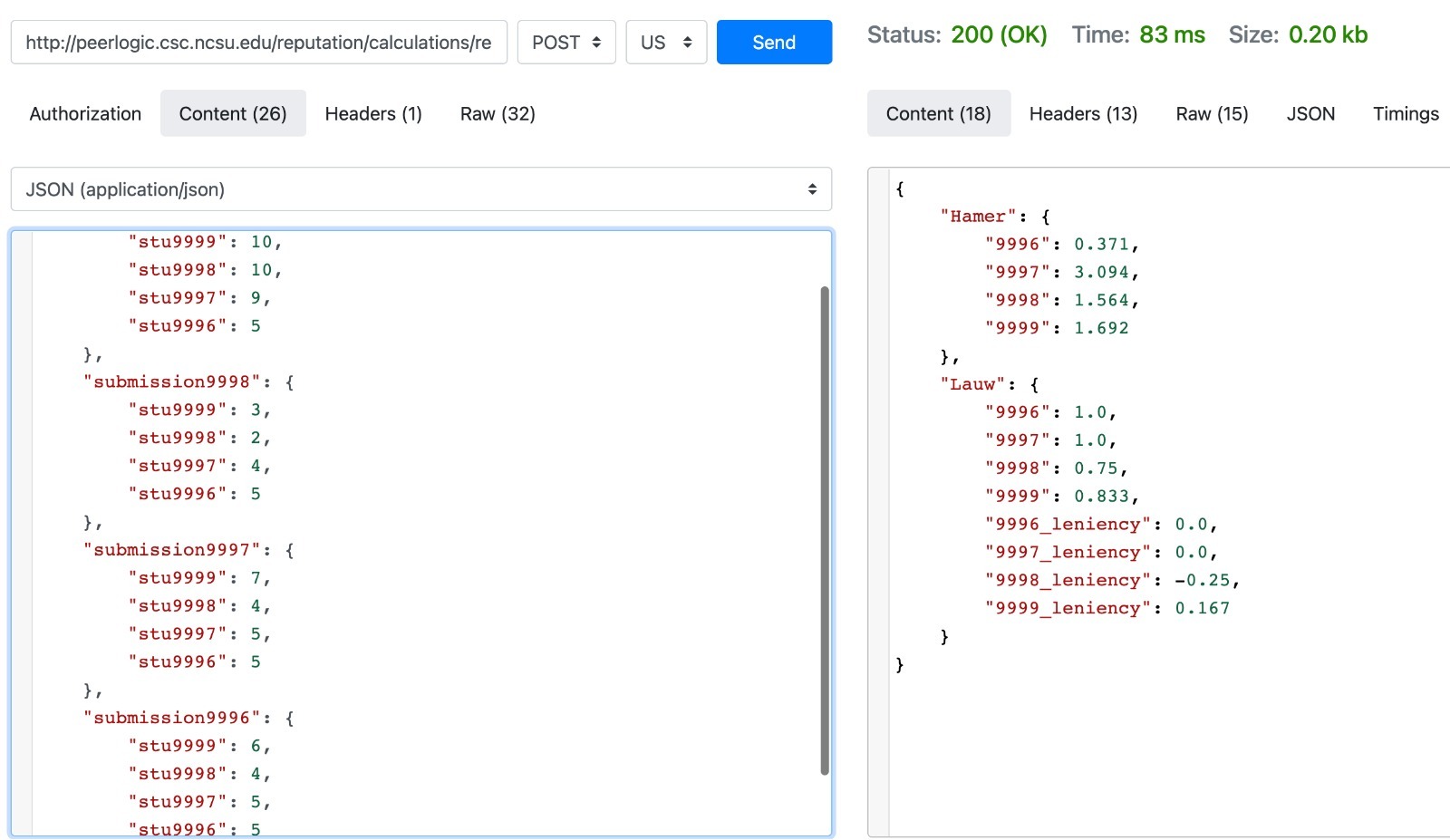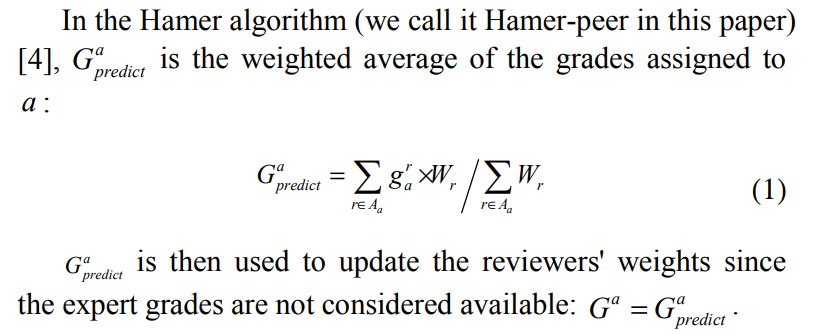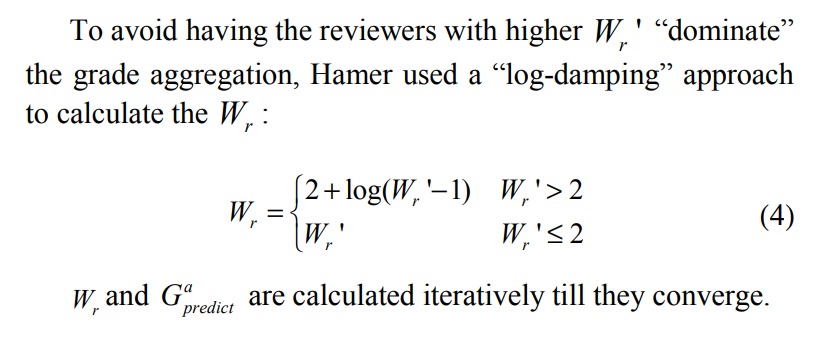CSC/ECE 517 Spring 2024 - E2412. Testing for hamer.rb
This page describes the changes made for the Spring 2024 Program 3: First OSS project E2412. Testing for hamer.rb
Project Overview
Problem Statement
The practice of using student feedback on assignments as a grading tool is gaining traction among university professors and courses. This approach not only saves instructors and teaching assistants considerable time but also fosters a deeper understanding of assignments among students as they evaluate their peers' work. However, there is a concern that some students may not take their reviewing responsibilities seriously, potentially skewing the grading process by assigning extreme scores such as 100 or 0 arbitrarily. To address this issue, the Hamer algorithm was developed to assess the credibility and accuracy of reviewers. It generates reputation weights for each reviewer, which instructors can use to gauge their reliability or incorporate into grading calculations. Our goal here is to test this Hamer algorithm.
Hamer Algorithm
The Hamer algorithm accepts a collection of assignment grades provided by reviewers, along with optional reputation weights associated with each reviewer. It then calculates a reputation weight value for each reviewer, indicating their reliability and accuracy. The Hamer algorithm outputs reputation weight values ranging from 0 to infinity, with higher values signifying greater credibility. For instance, a reviewer with a reputation weight of 49.0 is considered more dependable and precise in their evaluations compared to another reviewer with a reputation weight of 0.32. The following is an example from the paper that describes the Hamer algorithm
The original provided algorithm was hosted on the web server located at http://peerlogic.csc.ncsu.edu/reputation/calculations/reputation_algorithms. To utilize the algorithm, a POST request is made to the peerlogic URL containing a JSON body containing the grades for each assignment along with the respective reviewers who assigned those grades. Upon sending the request, a JSON response is returned containing the corresponding Hamer reputation weight values. Below is an example of a POST request to the peerlogic URL to obtain Hamer reputation values:
Objectives
- Calculate reputation scores based on paper "Pluggable reputation systems for peer review: A web-service approach"
- Assert the accuracy of the reputation web server's Hamer values through the URL http://peerlogic.csc.ncsu.edu/reputation/calculations/reputation_algorithms.
- Create a mock web server to return the correct Hamer values if the reputation web server's Hamer algorithm returns incorrect values.
Files Involved
- reputation_web_server_hamer.rb
- reputation_mock_web_server_hamer.rb
Mentor
- Muhammet Mustafa Olmez (molmez@ncsu.edu)
Team Members
- Neha Vijay Patil(npatil2@ncsu.edu)
- Prachit Mhalgi (pmhalgi@ncsu.edu)
- Sahil Santosh Sawant (ssawant2@ncsu.edu)
Algorithms
Reputation systems may take various factors into account: • Does a reviewer assign scores that are similar to scores assigned by the instructor (on work that they both grade)? • Does a reviewer assign scores that match those assigned by other reviewers? • Does the reviewer assign different scores to different work? • How competent has the reviewer been on other work done for the class?
There are two algorithms used, the Hamer-peer algorithm has the lowest maximum absolute bias and the Lauw-peer algorithm has the lowest overall bias.This indicates, from theinstructor’s perspective, if there are further assignments of this kind, expert grading may not be necessary. It is observed in the article (https://ieeexplore.ieee.org/abstract/document/7344292) that the overall bias is a little bit higher, but the max. absolute bias is very high (more than 20). This indicates that for future similar courses, the instructor can trust most students’ peer grading, but should be aware that the students may give inflated grades. Therefore spot-checking is necessary. However, overall bias is quite low, as the students gave grades at least 16 points lower than expert grades. This may because either more training is needed, or the review rubric is inadequate. The results also suggest that for future courses of this kind, the instructor cannot trust the students' grades; expert grades are still necessary. The main difference between the Hamer-peer and the Lauw-peer algorithm is that the Lauw-peer algorithm keeps track of the reviewer's leniency (“bias”), which can be either positive or negative. A positive leniency indicates the reviewer tends to give higher scores than average. Additionally, the range for Hamer’s algorithm is (0,∞) while for Lauw’s algorithm it is [0,1].
Hamer Algorithm
We implemented the steps of this algorithm for our analytical validation, found in the section below.
Test Plan - Initial Phase
In the initial phase, we were tasked with testing the reputation_web_service_controller. The work done by a previous project team was impacted by the web-service (peerlogic) not being available at that time. This time, we were able to access the Peerlogic server at a late stage - therefore, our plan at this moment involved performing a series of unit tests to determine that the web-service was communicating correctly with Expertiza.
Initial Testing Plan, Object Creation
1. Since our focus in this phase was to conduct exploratory testing of the system, we wrote some conventional tests to examine Peerlogic functionality. At this stage, we realized that Peerlogic would only accept and respond with JSON data.
2. Therefore, a natural next step was to prepare a series of input data that simulated a general input scenario for the system, comprising of:
- a. Each reviewer has assigned scores to 3 reviewees (fellow students)
- b. There are a total of 3 reviewers, who have all graded each other in some fashion for 5 assignments
- c. Convert this scenario to JSON
- d. Write code to PUT this to Peerlogic, and receive a response
- e. Parse through this response to obtain the output values of the Hamer Algorithm, as calculated by Peerlogic.
- f. This output would be compared against actual data that we calculated based on the Research Paper for the Hamer Algorithm
The code for the last step is shown below
import math
# Parameters: reviews list
# reviews list - a list of each reviewer's grades for each assignment
# Example:
# reviews = [[5,4,4,3,2],[5,3,4,4,2],[4,3,4,3,2]]
# Corresponding reviewer and grade for each assignment table
# Essay Reviewer1 Reviewer2 Reviewer3
# Assignment1 5 5 4
# Assignment2 4 3 3
# Assignment3 4 4 4
# Assignment4 3 4 3
# Assignment5 2 2 2
# Reivewer's grades given to each assignment 2D array
# Each index of reviews is a reviewer. Each index in reviews[i] is a review grade
reviews = [[5,4,4,3,2],[5,3,4,4,2],[4,3,4,3,2]]
# Number of reviewers
numReviewers = len(reviews)
# Number of assignments
numAssig = len(reviews[0])
# Initial empty grades for each assignment array
grades = []
# Initial empty delta R array
deltaR = []
# Weight prime
weightPrime = []
# Reviewer's reputation weight
weight= []
# Calculating Average Weighted Grades per Reviewer
for numAssigIndex in range(numAssig):
assignmentGradeAverage = 0
for numReviewerIndex in range(numReviewers):
assignmentGradeAverage += reviews[numReviewerIndex][numAssigIndex]
grades.append(assignmentGradeAverage/numReviewers)
print("Average Grades:")
print(grades)
# Calculating delta R
for numReviewerIndex in range(numReviewers):
reviewerDeltaR = 0
assignmentAverageGradeIndex = 0
for reviewGrade in reviews[numReviewerIndex]:
reviewerDeltaR += ((reviewGrade - grades[assignmentAverageGradeIndex]) ** 2)
assignmentAverageGradeIndex += 1
reviewerDeltaR /= numAssig
deltaR.append(reviewerDeltaR)
print("deltaR:")
print(deltaR)
# Calculating weight prime
averageDeltaR = 0
for reviewerDeltaR in deltaR:
averageDeltaR += reviewerDeltaR
averageDeltaR /= numReviewers
print("averageDeltaR:")
print(averageDeltaR)
# Calculating weight prime
for reviewerDeltaR in deltaR:
weightPrime.append(averageDeltaR/reviewerDeltaR)
print("weightPrime:")
print(weightPrime)
# Calculating reputation weight
for reviewerWeightPrime in weightPrime:
if reviewerWeightPrime <= 2:
weight.append(reviewerWeightPrime)
else:
weight.append(2 + math.log(reviewerWeightPrime - 1))
print("reputation per reviewer:")
i = 1
for reviewerWeight in weight:
print("Reputation of Reviewer ", i)
print(round(reviewerWeight,1))
i += 1
Initial Testing Conclusions
The results that are actually received from Peerlogic are presented below:

The results from our python recreated Hamer Algorithm are as followed:

As you can see, they do NOT match with expected results.
Therefore, our first conclusion is that the PeerLogic Webservice is implemented incorrectly.
This has been documented in the Conclusion section as the first point.
Changes to Project Scope
Test Plan - Second Phase, Object Creation
We followed the testing thought process recommended by Dr. Gehringer: In testing this service, we used an external program to send requests to a simulated service, and inspected the returned data. This decision was reached since our program of test was unfortunately not running, and could not be inspected in an ideal manner. Additionally, this method was recommended by Dr. Gehringer, our project mentor. Finally, we also added a test case that mocks a webservice and asserts the output, done in 2 ways:
- a. In the first code snippet, we send JSON to a webservice that returns the correct Hamer output, as Peerlogic should when fixed.
- b. In the form of an RSpec mock, in the second snippet below.
The test below sends real JSON to both peerlogic and mock. http://peerlogic.csc.ncsu.edu/reputation/calculations/reputation_algorithms
As we tested on the peerlogic and mock, current web-service is not correct, since the returned values do not match the expected values as can be seen in the picture.
This is what we are supposed to reach in this project.
Test Code Snippet:
require "net/http"
require "json"
#The following contains 4 reviewers who have scored 4 reviewees
# Parameters: reviews list
# reviews list - a list of each reviewer's grades for each assignment
# Input visualization:
# Corresponding reviewer and grade for each assignment table
# Reviewer-> stu9999 stu9998 stu9997 stu9996
# Assignment
# Assignment1 5 5 4
# Assignment2 4 3 3
# Assignment3 4 4 4
# Assignment4 3 4 3
INPUTS = {
"submission9999": {
"stu9999": 10,
"stu9998": 10,
"stu9997": 9,
"stu9996": 5
},
"submission9998": {
"stu9999": 3,
"stu9998": 2,
"stu9997": 4,
"stu9996": 5
},
"submission9997": {
"stu9999": 7,
"stu9998": 4,
"stu9997": 5,
"stu9996": 5
},
"submission9996": {
"stu9999": 6,
"stu9998": 4,
"stu9997": 5,
"stu9996": 5
}
}.to_json
#
#Values that would be returned by a correct Hamer implementation
EXPECTED = {
"Hamer": {
"9996": 0.6,
"9997": 3.6,
"9998": 1.1,
"9999": 1.1
}
}.to_json
#sends API request to Peeerlogic
describe "Expertiza" do
it "should return the correct Hamer calculation" do
uri = URI('http://peerlogic.csc.ncsu.edu/reputation/calculations/reputation_algorithms')
req = Net::HTTP::Post.new(uri)
req.content_type = 'application/json'
req.body = INPUTS
response = Net::HTTP.start(uri.hostname, uri.port) do |http|
http.request(req)
end
#assertion fails, as expected
expect(JSON.parse(response.body)["Hamer"]).to eq(JSON.parse(EXPECTED)["Hamer"])
end
end
#sends API request to Mock Hamer/Peerlogic Server
describe "Expertiza Web Service" do
it "should return the correct Hamer calculation" do
uri = URI('https://4dfaead4-a747-4be4-8683-3b10d1d2e0c0.mock.pstmn.io/reputation_web_service/default')
req = Net::HTTP::Post.new(uri)
req.content_type = 'application/json'
req.body = INPUTS
response = Net::HTTP.start(uri.hostname, uri.port, :use_ssl => uri.scheme == 'https') do |http|
http.request(req)
end
expect(JSON.parse("#{response.body}}")["Hamer"]).to eq(JSON.parse(EXPECTED)["Hamer"])
end
end
Second Phase Output
In addition, this plan enables us to test the current functionality by treating this system as a black box, and is able to provide conclusions on the accuracy of the implementation as a whole.
Therefore, in the section below, we have provided code that showcases this plan in action. The values returned by the algorithm are to be inspected both by code and by hand.
require "webmock/rspec" # gem install webmock -v 2.2.0
WebMock.disable_net_connect!(allow_localhost: true)
#Setting up test objects
INPUTS = {
"submission9999": {
"stu9999": 10,
"stu9998": 10,
"stu9997": 9,
"stu9996": 5
},
"submission9998": {
"stu9999": 3,
"stu9998": 2,
"stu9997": 4,
"stu9996": 5
},
"submission9997": {
"stu9999": 7,
"stu9998": 4,
"stu9997": 5,
"stu9996": 5
},
"submission9996": {
"stu9999": 6,
"stu9998": 4,
"stu9997": 5,
"stu9996": 5
}
}.to_json
#Result expectations are identical here, in order to maintain uniformity
EXPECTED = {
"Hamer": {
"9996": 0.6,
"9997": 3.6,
"9998": 1.1,
"9999": 1.1
}
}.to_json
#tests Peerlogic
describe "Expertiza" do
before(:each) do
stub_request(:post, /peerlogic.csc.ncsu.edu/).
to_return(status: 200, body: EXPECTED, headers: {})
end
it "should return the correct Hamer calculation" do
uri = URI('http://peerlogic.csc.ncsu.edu/reputation/calculations/reputation_algorithms')
#JSON conversion to ensure server compatibility
req = Net::HTTP::Post.new(uri)
req.content_type = 'application/json'
req.body = INPUTS
response = Net::HTTP.start(uri.hostname, uri.port, :use_ssl => uri.scheme == 'https') do |http|
http.request(req)
end
#parse the JSON response body to access values for algorithm of choice, which is Hamer
expect(JSON.parse(response.body)["Hamer"]).to eq(JSON.parse(EXPECTED)["Hamer"])
end
end
#our assertion proves this mock works
Edge Cases & Scenarios
We present these scenarios as possible test cases for an accurately working Peerlogic webservice.
1) Reviewer gives all max scores
2) Reviewer gives all min scores
3) Reviewer completes no review
- alternative scenario - reviewer gives max scores even if no inputs
These have not been implemented as there is no point in testing a system further when positive flows do not work. However, the code in the Initial Phase Section can be used to analytically calculate correct responses for future assertions. We have provided outputs to these scenarios below:
Coverage
We believe that after our edge cases are implemented for a working Peerlogic, and the assertions pass, that test coverage can then be adequately measured.
At this moment, test coverage is not a relevant statistic as no positive or negative flows functions correctly, as do any edge cases.
Conclusion
We as a team figured out the algorithms and applications and write some test scenarios. However, we did not have chance to work on web service since it does not work due to module errors. What we had is undefined method strip on Reputation Web Service Controller. Although sometimes it works on Expertiza team side, we were not able to see the web service working. We created some test scenarios and write a python code for simulate the algorithm.
- 1. In the code segment written to simulate the hamer.rb algorithm as described in "A Method of Automatic Grade Calibration in Peer Assessment" by John Hamer Kenneth T.K. Ma Hugh H.F. Kwong ::::(https://crpit.scem.westernsydney.edu.au/confpapers/CRPITV42Hamer.pdf), we take a list of reviewers and their grades for each assignment reviewed to compute the associated reputation weight. Since the algorithm described in the ::paper does not specify an original weight for first time reviewers, we coded it so the first time reviewers had an original weight of 1. In addition, this code does not have reviewer weights added in for reviewers who already ::have reputation weights but will be added in soon. Also, we followed the algorithm they mentioned in the paper to the dot, but even then the output values they wrote as the example did not match what we computed by hand and by ::code. In this situation, either we missed something completely or the algorithm has been changed. As we tested on the peerlogic and mock, current web-service is not correct, since the returned values do not match the expected ::values as can be seen in the picture. This can be what we are supposed to reach in this project.
- 2. In addition, we also found out that the reputation_web_service_controller.rb currently is broken and needs refactoring. While the client side of the reputation web service page runs, any attempt to submit grades to the ::reputation web server side results in an error.
- 3. We provided scenarios for future teams to implement once Peerlogic is running correctly.
- 4. We mocked an accurate webservice and showed what the expected JSON should be like.
GitHub Links
Link to Expertiza repository: here
Link to the forked repository: here
Link to pull request: here
Link to Github Project page: here
Link to Testing Video: here
References
1. Expertiza on GitHub (https://github.com/expertiza/expertiza)
2. The live Expertiza website (http://expertiza.ncsu.edu/)
3. Pluggable reputation systems for peer review: A web-service approach (https://doi.org/10.1109/FIE.2015.7344292)




